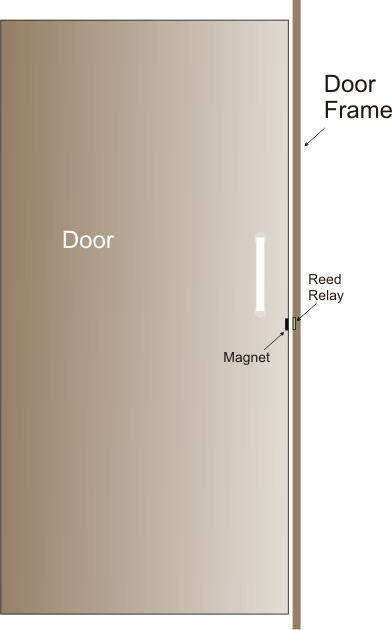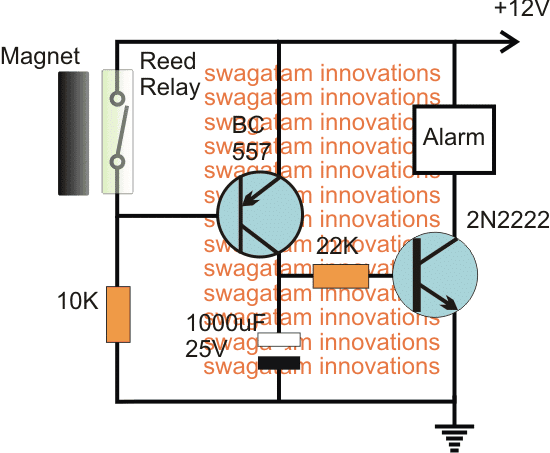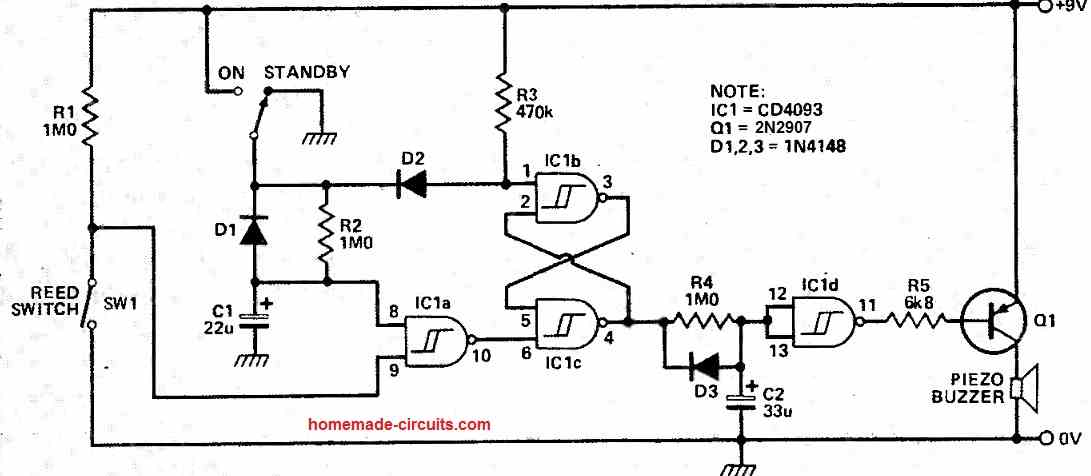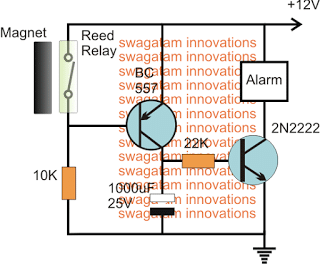The door security alarm circuit discussed in this article alerts the user whenever the door fitted with the circuit is opened or closed or even moved from its original locked position.
Using a Reed Relay and Magnet for the Triggering
The idea utilizes the very basic reed relay and magnet concept across the door and the door frame. The magnet is attached with the door edge, while the reed relay and its associated circuit is fixed on the door frame exactly adjacent to the door magnet, such that both are almost touching each other and separated only by the door and frame clearance.

This implies that whenever the door is moved or opened the magnetic influence on the reed relay is inhibited, which causes the associated circuitry to trigger the alarm.
The reed relay is connected with a delay OFF timer circuit, which makes sure that as soon as the door is opened or closed even for a fraction of a second causes the alarm to activate and sound for at least a few 10s of seconds, after which it automatically resets, until the door is moved yet again.

Parts List
- Resistors 1/4 watt 5%
- 10K = 1
- 22K = 1
- Capacitor Electrolytic
- 1000uF/25V = 1
- Transistors
- BC557 = 1
- 2N2222 = 1
- Alarm = Any piezo alarm siren unit
How it Works
The arrangement can be seen in the above diagram which shows how the door open close alarm circuit needs to be configured which appears pretty straightforward.
As long as the door remains in the closed position, the magnet enables the reed in the switched ON or "closed" position, which in turn keeps the PNP BC557 switched OFF.
With BC557 switched OFF, the 2N2222 is also unable to conduct, and thus the connected alarm module continues to be silent.
However in a situation where the door is moved or opened by an intruder, causes the the magnet to shift from its original position, which instantly opens and releases the reed internal contacts.
The above action now enables the BC557 to conduct, subsequently enabling the 2N2222 also to trigger and ultimately switch ON the connected alarm unit.
The intruder realizes this and tries to close the door in an attempt to shut off the alarm, however due to the presence of the 1000uF capacitor, and the 22K resistor at the base of the 2N2222, the transistor continues to conducts ensuring that the alarm is not switched off even though the door is restored at its initial position....thus the alarm stays latched ON and continues to raise the alarm forcing the intruder to surrender himself, until the 1000uF capacitor has discharged completely.
This little inexpensive yet highly efficient door opening alarm circuit can be used for securing any desired entrance from a possible intrusion without the need of a constant monitoring or without a guard in position.
Using IC 4093
This door alarm circuit is constructed around an affordable CMOS 4093 integrated circuit (IC) and offers a battery-operated burglar alarm for doors. The system incorporates both entry and exit delay functionalities.

The compact design of the unit makes it suitable to be enclosed in a small plastic enclosure, which can then be affixed to the inner side of the door requiring protection.
A small bar magnet is placed on the door frame, positioned within the range of the magnetic reed switch located in the alarm enclosure.
This setup ensures that the system functions as a self-contained unit, eliminating the need for any installation wiring.
How to Arm the Alarm
To activate the door alarm, simply turn the key switch from STANDBY to ON, and then leave the premises, ensuring the door is shut within 15 seconds (this time is determined by R2 and C1).
Subsequently, the alarm will arm itself, becoming responsive to any door openings. A flip-flop circuit constructed around IC1 b and e is utilized here.
Upon activation, C2 starts to charge through R4, creating an entry delay period lasting 20 seconds.
If the system is not switched back to the standby mode, the voltage across C2 eventually reaches the threshold of IC1 d.
As a result, Q1 energizes the piezo buzzer, triggering the audible alarm.
Resetting the system to its original state can be accomplished at any time by reverting the key switch to the STANDBY Mode.
The power consumption of the unit in both its active and standby states, without triggering the alarm, is minimal, enabling extended operation over time using a 9V PP3 battery.
